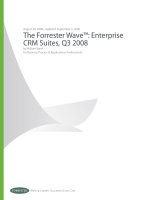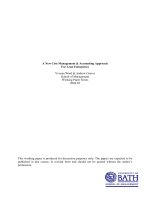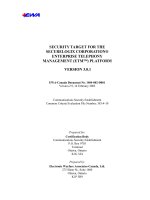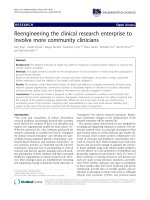The innovative lean enterprise
Bạn đang xem bản rút gọn của tài liệu. Xem và tải ngay bản đầy đủ của tài liệu tại đây (7.44 MB, 302 trang )
The Innovative
Lean Enterprise
Using the Principles of Lean to Create
and Deliver Innovation to Customers
For Business
and Technical
Professionals
Anthony Sgroi, Jr.
Tai Lieu Chat Luong
Endorsements
“Tony Sgroi has developed an innovative approach to making marketing decisions on a
Lean basis. Everything is done to create value and eliminate waste. He includes an interesting visual system for assessing and communicating the quality of any prospective marketing opportunity.”
Philip Kotler
S. C. Johnson & Son Distinguished Professor of International Marketing
Kellogg School of Management, Northwestern University
“Very rarely does a book get published that can make a huge difference to a business. The
Innovative Lean Enterprise is such a book. The information within this book is a road map
to Success. Every business reaches a point where it has to innovate or perish. Tony Sgroi
has given you the secret to succeed. By implementing each step Tony Sgroi has outlined
in each chapter, you will create a building block for success. I really wish I had this book
when I was developing my 35 companies.”
Ken Varga
Author of How to Get Customers to Call, Buy & Beg for More!
and 10 Marketing Mistakes That Steal Your Cash
“Tony Sgroi has made an important contribution to the discipline of strategic planning. By
adapting the visual management tools of “Lean” to both define ‘the now’… AND envision
new and innovative strategic futures, The Innovative Lean Enterprise makes it easy to discover and exploit unique competitive advantages for a brand, a division or a company!”
Bryan Mattimore
Co-Founder, The Growth Engine Company
Author, Idea Stormers: How to Lead and Inspire Creative Breakthroughs
“The topic of the book from Tony Sgroi is not only for people who are interested in starting a business, but also for any person involved in management of a business or government agency. The composition is very clear, and his step-by-step of how-to-do portrayal
assists the readers’ comprehension. In addition, the numerous diagrams and graphs add to
or enhance the meaning and provide a clear and attractive presentation to the reader. In
today’s economic and global downturn, Tony’s view on maximizing value while minimizing waste is essential to business and daily life.”
Dr. Henry C. Lee
Distinguished Chaired Professor, Forensic Science
The Henry C. Lee Institute of Forensic Science
“The Innovative Lean Enterprise is a great resource for business and technical leaders and
entrepreneurs! Tony has laid out his thoughtful insight in a manner that brings the full
force of his over 20 years experience as an engineer, manager, and patent agent registered
to practice before the United States Patent and Trademark Office to bear on the complex
topic of developing a winning strategy. As an intellectual property attorney and instructor
on business and legal topics, it is my opinion that Tony masterfully melded together these
components to help ensure the alignment of the strategies that support your business.”
Ned McMahon
Partner at Ohlandt, Greeley, Ruggiero & Perle, LLP.
“I found Tony Sgroi’s book very educational with graphic examples of how to move projects forward. He explains how complicated decisions can be made by breaking them down
into basic elements. A must read for entrepreneurs of every field.”
Don Gringer
Chairman, Allway Tools
“The Innovative Lean Enterprise is a vital resource for employees at all levels of your business. It presents a unique strategy framework highlighted with engaging examples to demonstrate successful implementation and execution of your business plan.”
Evan Anderson
President, Allway Tools
“The Innovative Lean Enterprise is an interesting perspective on the planning process. Its
approach is both easy to apply and beneficial. A should read for anyone in any field of
business.”
Chris Mills
President, North America Consumer Products
BIC USA Inc.
“After reading Mr. Tony Sgroi’s book The Innovative Lean Enterprise I was struck by the
depth of information and knowledge Tony was able to deliver. The book ties together
marketing strategy, innovation and Lean product development concepts very nicely. The
information in the book is powerful and will be important reading for most types of business professionals including general managers, brand marketing executives, and R&D
professionals.
I highly recommend reading The Innovative Lean Enterprise and believe it will be an
important addition to any company’s training effort focused on delivering customer value
and innovation in the marketplace.”
Steve O’Brien
Director, Global Human Resources
Unger Global Companies
The Innovative
Lean Enterprise
Using the Principles of Lean to Create
and Deliver Innovation to Customers
Anthony Sgroi, Jr.
CRC Press
Taylor & Francis Group
6000 Broken Sound Parkway NW, Suite 300
Boca Raton, FL 33487-2742
© 2014 by Taylor & Francis Group, LLC
CRC Press is an imprint of Taylor & Francis Group, an Informa business
No claim to original U.S. Government works
Version Date: 20130412
International Standard Book Number-13: 978-1-4822-0391-2 (eBook - PDF)
This book contains information obtained from authentic and highly regarded sources. Reasonable efforts have been
made to publish reliable data and information, but the author and publisher cannot assume responsibility for the validity of all materials or the consequences of their use. The authors and publishers have attempted to trace the copyright
holders of all material reproduced in this publication and apologize to copyright holders if permission to publish in this
form has not been obtained. If any copyright material has not been acknowledged please write and let us know so we may
rectify in any future reprint.
Except as permitted under U.S. Copyright Law, no part of this book may be reprinted, reproduced, transmitted, or utilized in any form by any electronic, mechanical, or other means, now known or hereafter invented, including photocopying, microfilming, and recording, or in any information storage or retrieval system, without written permission from the
publishers.
For permission to photocopy or use material electronically from this work, please access www.copyright.com (http://
www.copyright.com/) or contact the Copyright Clearance Center, Inc. (CCC), 222 Rosewood Drive, Danvers, MA 01923,
978-750-8400. CCC is a not-for-profit organization that provides licenses and registration for a variety of users. For
organizations that have been granted a photocopy license by the CCC, a separate system of payment has been arranged.
Trademark Notice: Product or corporate names may be trademarks or registered trademarks, and are used only for
identification and explanation without intent to infringe.
Visit the Taylor & Francis Web site at
and the CRC Press Web site at
For my wife, Tammy,
my daughter, Erica,
and my son, Tony
Contents
Acknowledgments........................................................................... xiii
Introduction......................................................................................xv
1 Visual Strategy..............................................................................1
First Parameter of Strategy...........................................................................2
Utility....................................................................................................3
Emotion................................................................................................3
Second Parameter of Strategy......................................................................4
Third Parameter of Strategy.........................................................................4
Fourth Parameter of Strategy.......................................................................5
Strategy Icon.................................................................................................7
Conclusion..................................................................................................16
Chapter Overviews....................................................................................16
Chapter 2: Understanding the Current State......................................16
Chapter 3: Opportunity Identification...............................................17
Chapter 4: Idea Generation................................................................17
Chapter 5: Delivering Profitable Innovation to Targeted
Customers...........................................................................................17
Chapter 6: Barriers to Imitation.........................................................17
Chapter 7: Applications of Graphical Strategy Tools.........................18
Chapter 8: Ranking Offerings............................................................18
Chapter 9: Strategy Transformation Process......................................18
Chapter 10: Strategy Transformation Example..................................18
Chapter 11: Alignment and Position Statements................................19
2 Understanding the Current State................................................21
2-D Perceptual Map...................................................................................22
2-D Map......................................................................................................24
Utility Knife Industry.................................................................................27
vii
viii ◾ Contents
First Innovation: The Retractable Utility Knife..................................27
Second Innovation: Quick Blade Change..........................................28
Third Innovation: Folding Utility Knives...........................................28
Switchback Knife................................................................................29
Product Features: Lock-Back-Style Folding Utility Knives................30
Product Features: Folding Retractable Utility Knife with Blade
Storage................................................................................................31
Product Features: Fast-Open Gravity Utility Knife............................31
Conclusion..................................................................................................39
3 Opportunity Identification.........................................................41
Must-Be Requirements...............................................................................43
One-Dimensional Requirements...............................................................43
Attractive Requirements.............................................................................44
Top Portion of Product Fulfillment Map...................................................47
Acquisition..........................................................................................47
Product Use........................................................................................47
Barriers to Use....................................................................................48
Product Robustness............................................................................48
End of Life..........................................................................................49
Left-Side Portion of Product Fulfillment Map...........................................49
Utility: Product Function Category....................................................49
Risk: Category in Which Customers Seek Risk Avoidance...............50
Simplicity or Convenience.................................................................50
Emotional Well-Being or Social Well-Being......................................51
Supports the Green Movement..........................................................51
Financial.............................................................................................52
Product Fulfillment Map Example.............................................................52
Opportunity Scores....................................................................................56
Conclusion..................................................................................................61
4 Idea Generation..........................................................................63
Internal Perspective Techniques................................................................64
Surveys................................................................................................65
Focus Groups.....................................................................................65
One-on-One Interview......................................................................66
Intercepts............................................................................................66
Product User Testing..........................................................................66
Customer Feedback and Complaints................................................. 67
Ethnographic Research....................................................................... 67
Contents ◾ ix
Idea Generation.................................................................................. 67
Problem Solution Statement...............................................................68
Job Mapping.......................................................................................68
Internal Ideation Methods.........................................................................70
Brain Writing......................................................................................70
Brain Walking.....................................................................................70
Worst Idea...........................................................................................71
Patent Prompts...................................................................................71
Picture Prompts..................................................................................71
White Board Technique.....................................................................72
External Perspective Techniques...............................................................72
Looking to Alternative Industries......................................................73
Looking to Alternate Strategic Groups..............................................76
Looking at Different Buyer Groups...................................................78
Looking to Complementary Product and Service Offerings.............83
Adding or Removing Functional or Emotional Characteristics.........85
Identifying New Trends.....................................................................89
Conclusion..................................................................................................92
5 Delivering Profitable Innovation to Targeted Customers...........93
Utility..........................................................................................................95
Emotion......................................................................................................95
Conclusion................................................................................................ 113
6 Barriers to Imitation................................................................. 115
Brand Power............................................................................................. 116
Firm’s Knowledge.................................................................................... 117
Customer Relationships............................................................................ 117
Supplier Relationships.............................................................................. 118
High-Efficiency Operations..................................................................... 118
Skill of People.......................................................................................... 118
Processes.................................................................................................. 118
Technology and Money........................................................................... 119
Regulatory Pioneering.............................................................................. 119
Economies of Scale.................................................................................. 119
Switching Cost of the Consumer.............................................................120
Intellectual Property................................................................................ 121
Patents............................................................................................... 121
Types of Patents.......................................................................................123
Patent Claims....................................................................................125
x ◾ Contents
The Power of Patent Pending (a defensive tool).............................129
Trademarks.......................................................................................132
Trade Dress as an IP Tool................................................................132
Copyrights as an IP Tool..................................................................133
Trade Secrets as an IP Tool..............................................................133
Conclusion................................................................................................134
7 Applications of Graphical Strategy Tools.................................137
SWOT Analysis......................................................................................... 145
Strength............................................................................................. 146
Weakness..........................................................................................146
Opportunities...................................................................................146
Threats.............................................................................................. 147
Balanced Scorecard Approach................................................................. 149
Learning and Growth Perspective................................................... 149
Business Process Perspective........................................................... 150
Customer Perspective....................................................................... 150
Financial Perspective........................................................................ 151
Disruptive Innovation.............................................................................. 152
New Market Disruptions.................................................................. 153
Low-End Disruptions........................................................................ 154
Conclusion................................................................................................ 159
8 Ranking Offerings.................................................................... 161
Conclusion................................................................................................ 175
9 Strategy Transformation Process.............................................. 177
10 Strategy Transformation Example............................................ 193
Conclusion................................................................................................226
11 Alignment and Position Statements..........................................227
Conclusion................................................................................................237
12 Epilogue....................................................................................239
Bibliography....................................................................................243
Appendix 1......................................................................................247
Appendix 2...................................................................................... 251
Appendix 3......................................................................................261
Contents ◾ xi
Notes................................................................................................271
About the Author.............................................................................291
Acknowledgments
I am grateful to many people who I have encountered throughout my
journey. For the beginning of my journey, I owe many thanks to a select
few professors in my early adult life. George Geyer was one particular
individual who provided me with the confidence that I could learn physics. I don’t know if I would have continued school if I never crossed his
path.
I also thank the dedicated professors at the University of New Haven. The
professors within the Department of Mechanical Engineering are second to
none. The same holds true for the professors whom I experienced in the
executive MBA program. Your teachings helped me to realize that a wellrounded executive extends past engineering.
Special thanks to James Champy, who spent the time to review my first
manuscript. Your recommendations shaped this book to where it is today.
I owe many thanks to the team of CRC Press. My gratitude first extends
to Kristine Mednansky. Thank you for seeing the book beyond the original
title and suggesting the title change. I also thank Kate Gallo for all of her
hard work in putting the pieces of this book together as well as Jay Margolis
for his help during the editing of this book and Sophie Kirkwood, the
typesetter.
I owe many thanks to my parents. Your constant encouragement to
become an engineer while tinkering with everything around the house has
created my career path. This has truly made me who I am today. Dad, sorry
about the lawn mower, welding your toolbox shut, your lost tools, all of the
loose chairs, and jamming up the key locks with toothpicks.
Finally, I thank my wife, Tammy, for standing by me all these years as I
continued to build on my knowledge base. Any success that I have achieved
or will achieve would not be possible without her continuous support.
xiii
Introduction
During the time period of preparing this manuscript, I was struggling with
a proper name for this book. My first proposed title was Iconic Strategy.
In the beginning, I believed the title was appropriate. But as I began to
receive feedback on the book, I soon realized that Iconic Strategy did not
properly describe the book. This book is more about innovation. I therefore struggled with other title ideas, such as Reinnovating the Corporation,
Business Model Reengineering, and finally Reinventing the Corporation.
Again, these titles did not properly describe this book. As I began to ponder additional titles, I soon realized that this book is more about creating
and delivering customer value and innovation. I further realized that in this
process, anything that did not contribute to creating customer value and
innovation was waste. I then linked this process to the principles of Lean.
With these thoughts in mind, the creation of the title became rather easy
for me.
The broad theme of Lean resides in the concept of maximizing value
and minimizing waste. Minimizing or eliminating waste is rather a straightforward concept and begins with the customer. During the beginning
stages of product development, any activity that does not contribute to the
understanding of the customer is waste. It is this crucial stage that fuels the
remainder of product development activities. The last thing any business
wants is to effectively develop a product that customers are not willing or
motivated to purchase.
The motivation to purchase depends on understanding what is valued
by the customer. When this value is discovered, created, and delivered in
the form of an offering customers are willing to pay for, demand is created. This demand results in value generation for businesses. Lean thinking begins by focusing on these initial principles before large resources are
deployed. Understanding demand in the beginning maximizes value for
xv
xvi ◾ Introduction
the company and minimizes the waste of developing and launching the
wrong product.
Many principles of Lean product development are based on the works of
Allen C. Ward.1 Ward spent considerable time studying the product development methods of the Wright Brothers and how their approach to product
development was similar to that of Toyota. Along with his observations and
direct experience, Ward invented set-based concurrent engineering (test
before design) and began the concept of Lean product development. Today,
many companies are trying to understand Ward’s works and are attempting
the application of Lean product development to their organizations. Several
books have been written about Lean and have been sold so others can
make the attempt to understand the principles of Lean product development.
Despite the amount of literature available, many organizations still struggle
in the application of Lean.
Successful implementation of Lean requires cross-functional teamwork.
Therefore, in order to apply Lean successfully, teams are formed for each
product development project. Each team comprises one or more expert
individuals who represent each of their respective disciplines, for example,
a product development expert representing R&D, an expert tooling engineer
representing manufacturing, an expert marketer representing marketing, an
expert in supply chain representing operations, and so on. Each of these
members must be willing to work together as a team with a systems design
approach where the team has one simple and important goal: aligning all
activities to provide customer value while relentlessly driving out waste. The
team will report to a specific type of project manager dubbed the entrepreneurial system designer (ESD), who has intimate experience working across
all disciplines. In addition, and probably most important, the ESD has full
in-depth understanding of the customer.
Each team member must be an expert in his or her related field and must
hold himself or herself and the team accountable for results. This mindset
forms a team of responsible experts. The sure test for this is to verify that
each team member has the ability to actually perform the work in the areas
that he or she is responsible for. In addition, each team member must have
sufficient levels of understanding for the needs of his or her cross-functional
team members. For example, if a product’s aesthetics is contributing to a
difficult injection molding process, then R&D should have an appreciation of
that difficulty and alter the design as required.
A Lean organization is an organization built on trust. Trust allows the
team and its developers the power to make the appropriate decisions at
Introduction ◾ xvii
Understanding Value
Culture
Identifying & Reducing
Waste
Supplier Relationships
Entrepreneur System Designer
“Chief Engineer”
Knowledge Capture
Tools
Set-Based Concurrent Engineering
Tradeoff Thinking & Curves
Book of Knowledge
Problem Solving
Balancing Portfolio Projects
and Project Types
LEAN Visual Management
Teams of Responsible
Experts
Figure 0.1 Lean tools vs. company culture. (From Anthony Sgroi Jr.)
every level necessary to move the development to a successful completion.
The leaders are there for support and do not dictate orders. These individuals mentor their respective subordinates to create organizational learning,
which allows for decisions to be made at all levels. A manager who merely
gives orders and pushes paperwork will not be effective in a Lean organization. This concept, in addition to a skilled workforce, provides the only way
organizations can develop products as quickly and efficiently as possible.
Companies should strive to do whatever it takes to achieve that level of trust
in their organization or Lean will never become a reality.
Lean product development has several areas of focus, each being important both on an individual basis and in combination. Understanding certain
parts of Lean on an individual basis allows companies the luxury to begin to
implement certain portions of Lean rather quickly. By studying the founding
principles, companies can begin to understand the challenge in implementing one or more aspects of Lean. This of course will depend on the culture
of the company. The reader is encouraged to study the illustration shown in
Figure 0.1.
As illustrated by Figure 0.1, it is quite clear that the full implementation
of Lean is heavily dependent on company culture. Roughly speaking, implementing Lean requires five-eighths cultural acceptance and three-eighths
implementation of the various Lean tools. Thus, it is no accident that many
companies struggle in their endeavor of Lean implementation.
xviii ◾ Introduction
This book has been developed to focus on certain aspects of Lean. In
order to better target a larger audience in business, various portions of Lean
will be used to drive innovation and portfolio (marketing mix) planning.
This topic is certainly the optimum place to begin any new Lean endeavor,
as businesses must provide an optimum product or product mix to drive
sales. In addition, beginning with an understanding of the customers and
what is important to them will benefit product developers as well as others
in the organization. This includes marketers, strategists, senior managers,
and even the officers of companies. Our journey begins with a brief discussion of various Lean principles. After these discussions, the applicable portions of Lean to drive customer innovation are identified. This will serve as
the basis for the discussions throughout this book. Brief explanations of the
various parts of Lean follow.2
Value Creation
Lean strives for the understanding and creation of customer value. Anything
that contributes to a better understanding of the customer in terms of his or
her needs and wants (sometimes referred to as voice of the customer [VOC])
is value. Value is also the connected activities (sometimes referred to as the
value stream) that create and deliver a profitable value proposition to the
customer. Value is also created if these activities fail in the procurement of a
value proposition provided learning is achieved and knowledge is retained
and can be reused later. This can prevent a future market miss. Markets are
missed when the development team fails to understand the customer, or
because the product is not innovative enough, or cost and quality problems
exist. This value drives operations in the areas of manufacturing and procurement. Therefore, any activity that improves operational efficiency in the
delivery of the value proposition to the customer is value.
Reduction of Waste
Lean strives to remove all forms of waste in product development.
Unnecessary and time-consuming meetings, excessive reports, excessive
specifications, waiting, etc. are some examples of waste. As a check, personnel should always verify that if the time being spent is not contributing to
customer or company value, then this time is attributed to waste and should
Introduction ◾ xix
be eliminated or minimized. This includes overdelivery of features to the
customer. If products are loaded with too many features that do not target
important needs of customers, waste is present. This condition adds cost
and complexity that customers may not be willing to accept and pay for.
The most critical waste in product development is discarded knowledge.
There is nothing worse than discarding hours of valuable knowledge that
will require a future repeat of work. Knowledge must be retained and readily available.
Entrepreneurial System Designer (ESD)
Lean companies utilize a program manager who has a full understanding of the customer and all of the activities associated with delivering the
value proposition. This is the one person who is responsible for the entire
product development project. He or she is responsible for the engineering and aesthetic design, ease of manufacturing, quality, and market and
business success of the product. He or she is also an expert in the design
of the entire system. Such expertise optimizes the interactions of the
subsystems of the design. For example, a robust engine for a car must be
used with an equally robust drivetrain. This maintains the balance of the
design. Alternate selections for drivetrains could result in unit damage or
a high-cost overdesigned unit for a specific engine. ESDs understand how
subsystems interact together. Think of this person as a project manager
on steroids that truly understands the entire value stream of the product.
Beginning with intimate knowledge of the customer and transforming the
development of products that meet customer requirements, the ESD must
ensure that the company can in a timely manner provide these products
at the lowest possible cost, with high perceived quality, and must ensure
that the organization learns and retains new leading-edge knowledge. The
ESD leads a team of responsible experts in the conception and creation of
products.
Teams of Responsible Experts
Lean organizations mentor their people to become experts in their respective fields. These experts also have a deep understanding of their team
member’s needs in their respective fields of discipline. This is necessary
xx ◾ Introduction
to drive cross-functional success. Lean product development organizations
develop managers who are rewarded based on the creation and retention
of knowledge that leads to profitability and customer satisfaction. These are
people who are constantly learning to better themselves, their cross-functional team, and their organization. They are individuals who have working
knowledge and strive to get their hands dirty, ensuring that they are achieving a full understanding of their area of discipline. These individuals know
that once they stop learning, they cease to provide value. These individuals
refrain from becoming bureaucrats and hold themselves responsible and
accountable for results.
Set-Based Concurrent Engineering
Lean organizations are learning organizations. By testing multiple alternatives before development begins, the failure points of these alternatives can be determined prior to costly product development and testing.
This allows for the rapid elimination of weak alternatives early on. The
remaining, more robust alternatives can be selected if their failure points
lie above the targeted range of the product requirements. Another term
for set-based concurrent engineering is rapid learning cycles or test before
design. Lean organizations using proper set-based methods have very little
need for failure mode and effects analysis (FMEA). Another way of thinking about this is to simply perform more up-front learning, ensuring that
all knowledge gaps are eliminated. This avoids expensive time-consuming
modifications later, when tools are built and the product is near launch.
This is especially important when learning about customer needs and
wants.
Lean (Flexible) Project Management
Lean organizations reject the concept that managers plan and workers do.
Rather, developers plan their own work and work through their plans under
the guidance of a coach. Projects are broken down into smaller milestones
or batches, and the developers plan their work to meet these milestones.
This allows engineering work to be pulled instead of scheduled. Simple and
visual communication networks are established so that information is made
Introduction ◾ xxi
available to people requiring such information. This eliminates wasteful
management structures and reports.
Visual Management Tools
Lean organizations rely heavily on visual management. With the notion
that information is captured in only one place, it is not uncommon that
Lean companies utilize an entire wall to hang visual project information.
Lean companies also utilize effective reports that fit on a single sheet of
paper. These reports are designed to fit on A3-sized paper and are thus
denoted as A3 reports. They communicate a vast amount of information
utilizing as many graphics, illustrations, and graphs as possible. This creates a simple, innovative, and effective communication tool. There are many
forms of these reports used by companies. Some examples are project status
reports, knowledge capture reports, and problem-solving reports. In this
book, the concept of visual management tools will serve as the dominating
framework.
Knowledge Reuse
Lean organizations strive to create and archive knowledge so that it is
readily available for reuse. This allows faster and more predictable results
with respect to product development, as much is learned early on. When
an abundance of knowledge is available for reuse, developers can simply take what is needed from a knowledge base. This results in fewer
subsystems to develop within a system. Some examples are subsystem
design, research, standard parts, 3-D computer-aided design (CAD) files
of widely used components and assemblies, automated spring programs,
test data, etc.
Supplier Relationships
Lean organizations understand that it is essential that their suppliers share in
the total available profit. By building strong relationships with key suppliers,
trust is gained, resulting in higher levels of quality. It is best to have fewer
key suppliers that deliver high levels of quality on a consistent basis than to
xxii ◾ Introduction
shop for multiple low-cost suppliers. Strong supplier relationships can also
result in shared development, ultimately lowering the cost and lead time for
product launches.
Balancing Portfolio Projects and Project Types
Lean organizations understand that resources are limited. Offerings (product portfolios or the mix of product features) must be balanced with the
resources of the organization. Proper planning is necessary to create a balanced offering. In some cases, innovation can occur in a single subsystem,
unlocking new opportunities. In other cases, only incremental improvements
are necessary for market penetration. In the extreme, new products requiring new manufacturing equipment may be necessary. These decisions are
based on an understanding of the market needs in a business. This requires
the vision of strong leaders. Portfolio planning is a key component that
drives company success. The key is to provide a sustainable offering targeted
to a market sufficient in size to profit in the long term.
Problem Solving
Lean companies systematically solve problems and transfer this knowledge
throughout the organization and to new development programs. When
companies learn how to solve problems at the root, problems go away and
never resurface.
Go and See
Lean companies instill the notion of going to the source to fuel development
and problem solving. Before new products are defined, Lean companies
send the appropriate people to customer locations to better understand the
customer. When a machine is malfunctioning, problem solvers automatically
go to the source of the problem to verify the problems themselves. Lean
organizations do not make decisions solely on the creation of reports of others. By getting close to the source of any challenge, proper decisions can be
made as to the best countermeasure to be implemented.
Introduction ◾ xxiii
Chosen Lean Principles
The discussions above represent some of the main topics of Lean.
Although this book is not intended to teach the entire Lean system, it
is rather important that the reader becomes familiar with the terms. It
is the intention of this book to utilize certain portions of Lean to drive
innovation and company planning using a simple and visual process.
This book will accomplish this important goal as business planning must
reflect a long-term strategic goal of understanding what is valuable to the
customer and effectively form an offering targeting this value with little
to no waste. This book will discuss customer value in the form of benefits to customers’ desire. The discussions will also include driving out
waste (providing unnecessary product features), leading to higher cost of
offerings. By using set-based techniques, unnecessary offerings can be
eliminated rather early. This will allow for fewer, more important offerings required for evaluation. The results of this planning will be communicated using visual management tools specific to this book. This will
allow for simple and effective communication that will make knowledge
capture easy for executives.
This book also includes a very simple step-by-step process taken from
Lean principles to effectively and rapidly evaluate the current state of a company and the steps to define a totally new and unique innovative strategy.
It is also equally important to format the strategy in such a way that easy
and visual communication is possible. This book will form the beginning of
Lean thinking for executives.









